ECO2 Assignment: Analysis of Australian Economy Performance 2015-2019
VerifiedAdded on 2022/10/13
|12
|2309
|14
Report
AI Summary
This report examines the state of the Australian economy, analyzing key macroeconomic indicators such as GDP growth rate, unemployment, inflation, terms of trade, current account, net foreign debt, and the value of the Australian dollar from 2015 to 2019. The analysis reveals that while the economy has performed well in certain areas, such as terms of trade and unemployment, it has faced challenges in others, including GDP growth and the value of the Australian dollar. The report highlights the impact of global economic factors, such as the Chinese economy and fluctuating exchange rates, on Australia's economic performance. Finally, the report identifies and discusses three major issues facing the Australian economy in the coming 12 months: potential production shortages, the impact of higher interest rates, and the effect of exchange rate fluctuations on infrastructure development. The report concludes by summarizing the overall performance and vulnerabilities of the Australian economy based on the available data.
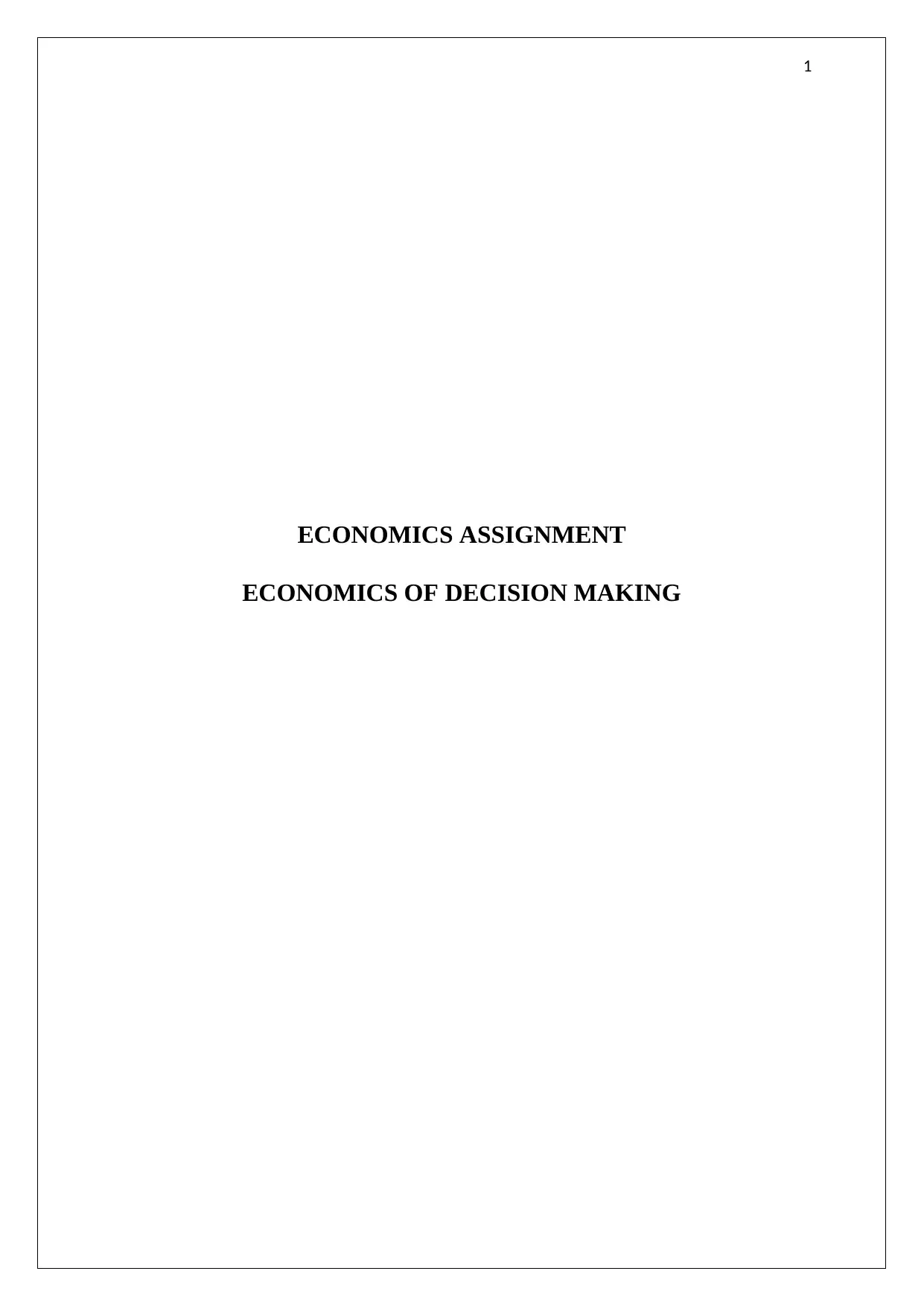
1
ECONOMICS ASSIGNMENT
ECONOMICS OF DECISION MAKING
ECONOMICS ASSIGNMENT
ECONOMICS OF DECISION MAKING
Paraphrase This Document
Need a fresh take? Get an instant paraphrase of this document with our AI Paraphraser
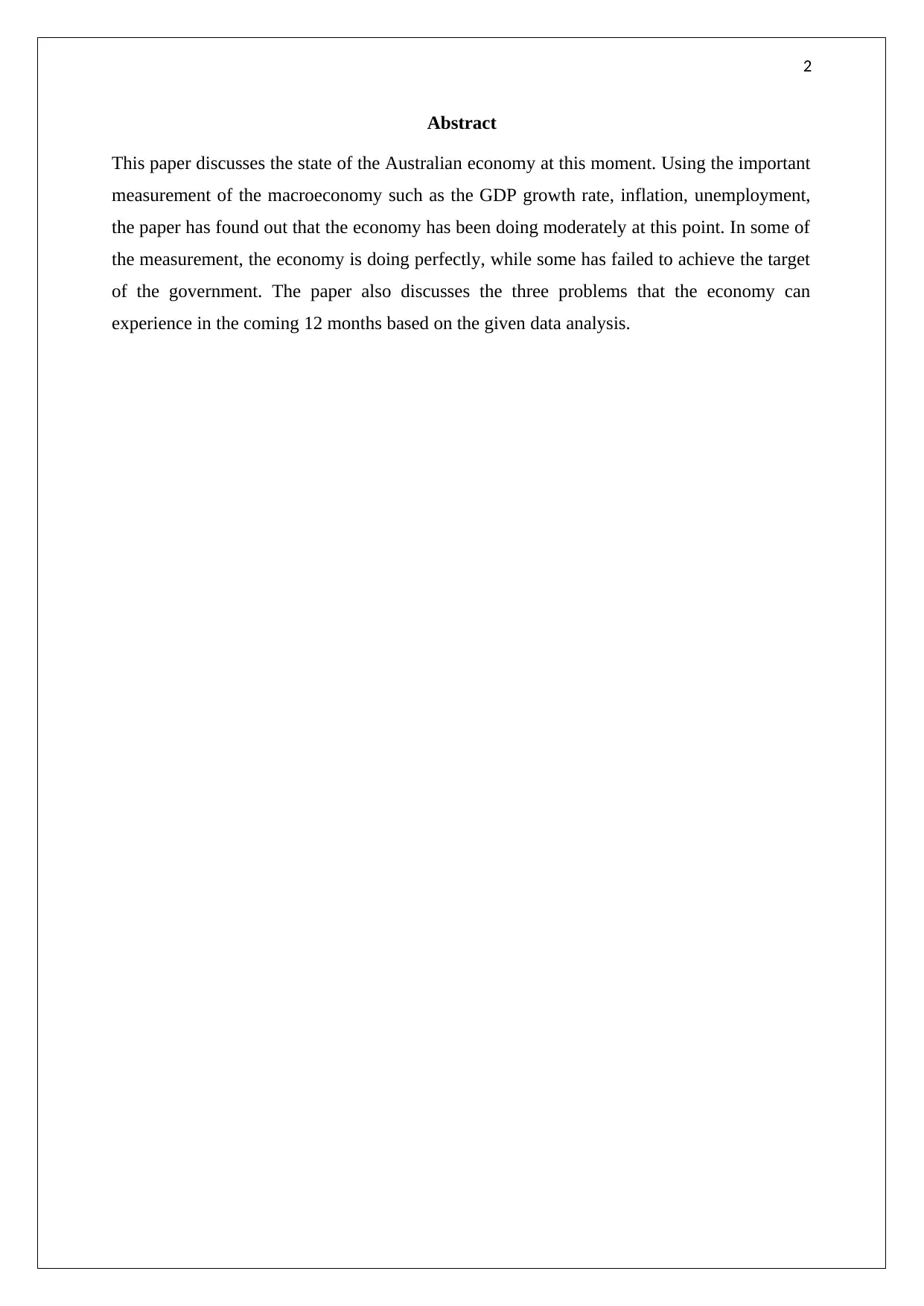
2
Abstract
This paper discusses the state of the Australian economy at this moment. Using the important
measurement of the macroeconomy such as the GDP growth rate, inflation, unemployment,
the paper has found out that the economy has been doing moderately at this point. In some of
the measurement, the economy is doing perfectly, while some has failed to achieve the target
of the government. The paper also discusses the three problems that the economy can
experience in the coming 12 months based on the given data analysis.
Abstract
This paper discusses the state of the Australian economy at this moment. Using the important
measurement of the macroeconomy such as the GDP growth rate, inflation, unemployment,
the paper has found out that the economy has been doing moderately at this point. In some of
the measurement, the economy is doing perfectly, while some has failed to achieve the target
of the government. The paper also discusses the three problems that the economy can
experience in the coming 12 months based on the given data analysis.
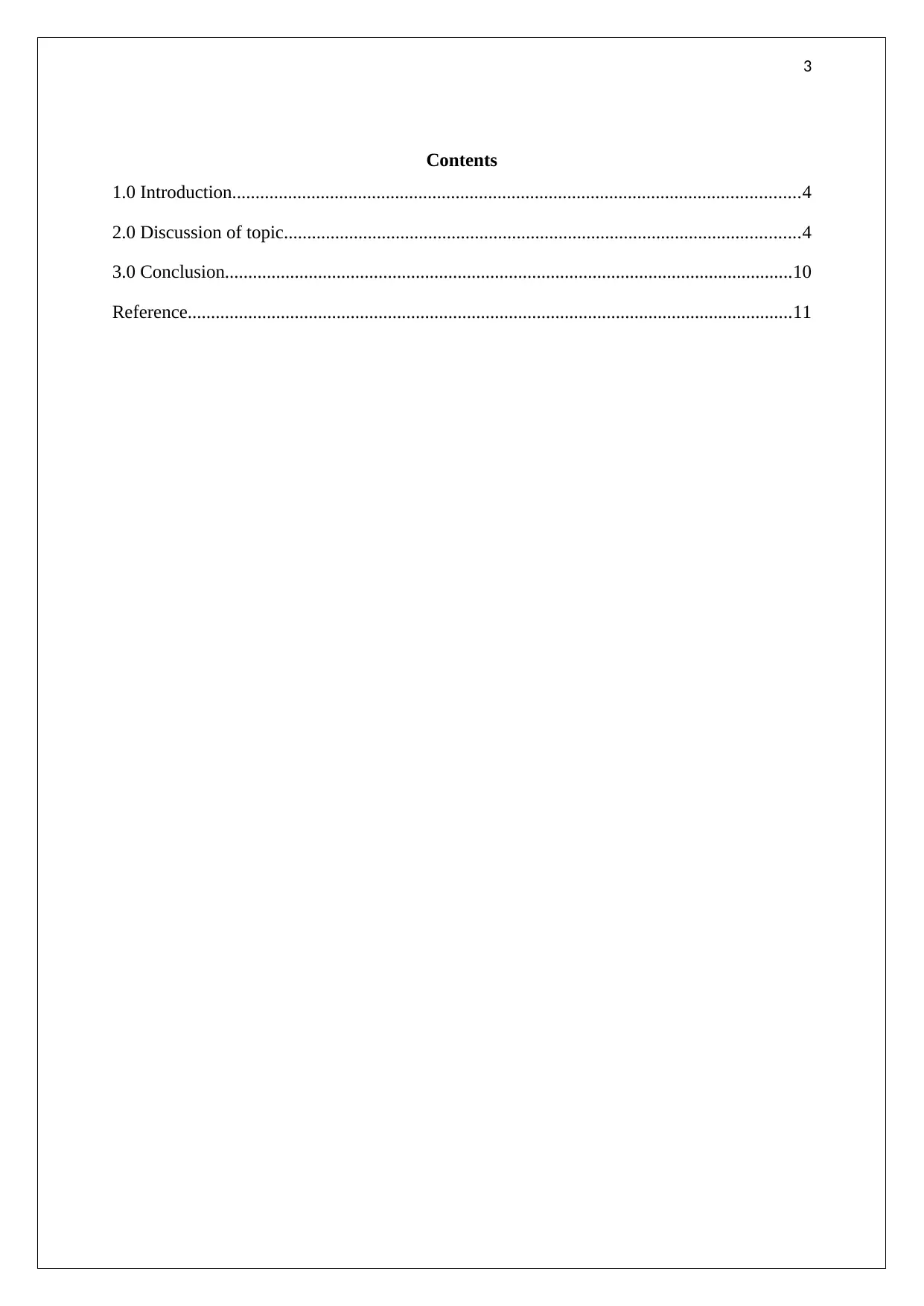
3
Contents
1.0 Introduction..........................................................................................................................4
2.0 Discussion of topic...............................................................................................................4
3.0 Conclusion..........................................................................................................................10
Reference..................................................................................................................................11
Contents
1.0 Introduction..........................................................................................................................4
2.0 Discussion of topic...............................................................................................................4
3.0 Conclusion..........................................................................................................................10
Reference..................................................................................................................................11
⊘ This is a preview!⊘
Do you want full access?
Subscribe today to unlock all pages.

Trusted by 1+ million students worldwide
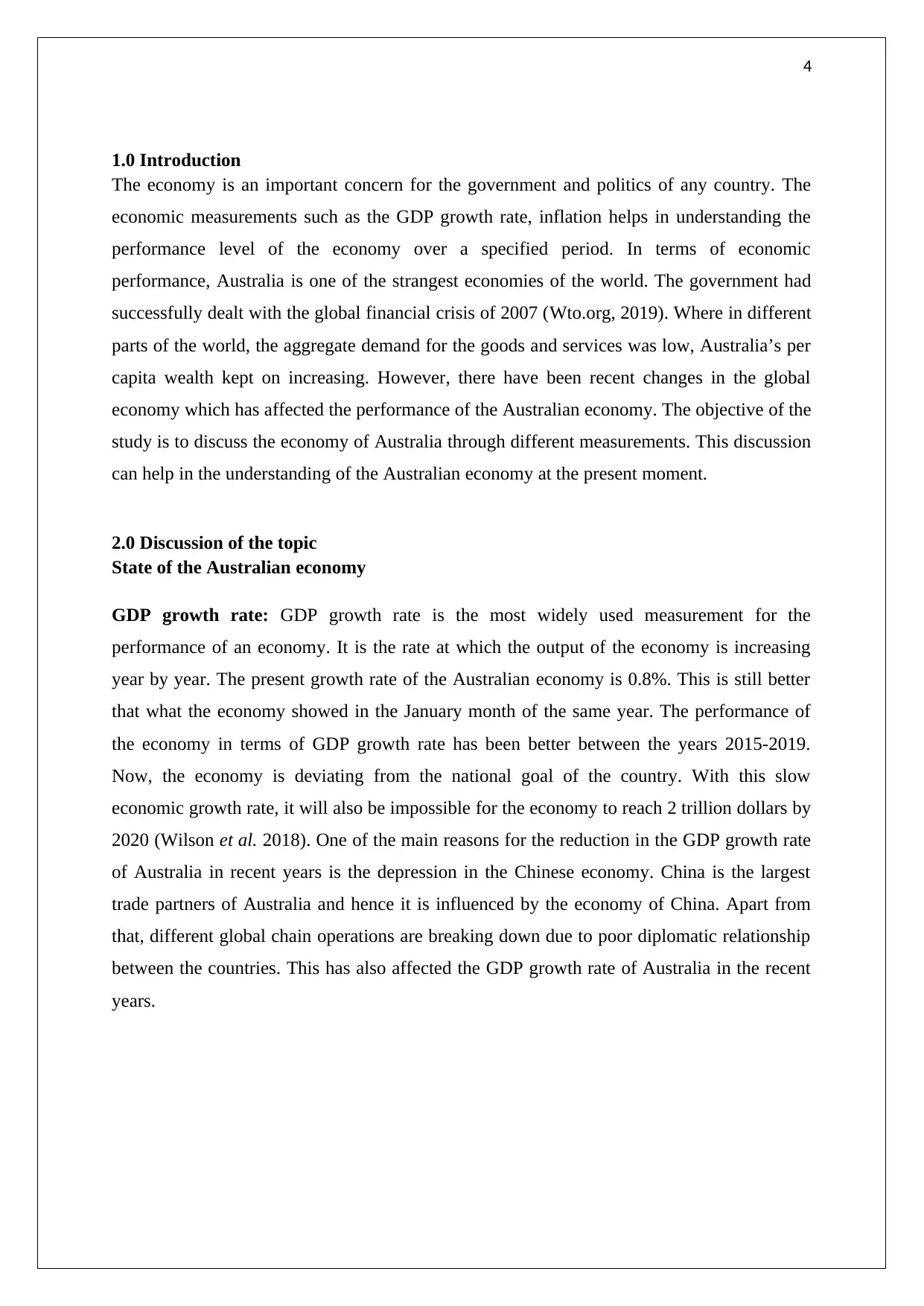
4
1.0 Introduction
The economy is an important concern for the government and politics of any country. The
economic measurements such as the GDP growth rate, inflation helps in understanding the
performance level of the economy over a specified period. In terms of economic
performance, Australia is one of the strangest economies of the world. The government had
successfully dealt with the global financial crisis of 2007 (Wto.org, 2019). Where in different
parts of the world, the aggregate demand for the goods and services was low, Australia’s per
capita wealth kept on increasing. However, there have been recent changes in the global
economy which has affected the performance of the Australian economy. The objective of the
study is to discuss the economy of Australia through different measurements. This discussion
can help in the understanding of the Australian economy at the present moment.
2.0 Discussion of the topic
State of the Australian economy
GDP growth rate: GDP growth rate is the most widely used measurement for the
performance of an economy. It is the rate at which the output of the economy is increasing
year by year. The present growth rate of the Australian economy is 0.8%. This is still better
that what the economy showed in the January month of the same year. The performance of
the economy in terms of GDP growth rate has been better between the years 2015-2019.
Now, the economy is deviating from the national goal of the country. With this slow
economic growth rate, it will also be impossible for the economy to reach 2 trillion dollars by
2020 (Wilson et al. 2018). One of the main reasons for the reduction in the GDP growth rate
of Australia in recent years is the depression in the Chinese economy. China is the largest
trade partners of Australia and hence it is influenced by the economy of China. Apart from
that, different global chain operations are breaking down due to poor diplomatic relationship
between the countries. This has also affected the GDP growth rate of Australia in the recent
years.
1.0 Introduction
The economy is an important concern for the government and politics of any country. The
economic measurements such as the GDP growth rate, inflation helps in understanding the
performance level of the economy over a specified period. In terms of economic
performance, Australia is one of the strangest economies of the world. The government had
successfully dealt with the global financial crisis of 2007 (Wto.org, 2019). Where in different
parts of the world, the aggregate demand for the goods and services was low, Australia’s per
capita wealth kept on increasing. However, there have been recent changes in the global
economy which has affected the performance of the Australian economy. The objective of the
study is to discuss the economy of Australia through different measurements. This discussion
can help in the understanding of the Australian economy at the present moment.
2.0 Discussion of the topic
State of the Australian economy
GDP growth rate: GDP growth rate is the most widely used measurement for the
performance of an economy. It is the rate at which the output of the economy is increasing
year by year. The present growth rate of the Australian economy is 0.8%. This is still better
that what the economy showed in the January month of the same year. The performance of
the economy in terms of GDP growth rate has been better between the years 2015-2019.
Now, the economy is deviating from the national goal of the country. With this slow
economic growth rate, it will also be impossible for the economy to reach 2 trillion dollars by
2020 (Wilson et al. 2018). One of the main reasons for the reduction in the GDP growth rate
of Australia in recent years is the depression in the Chinese economy. China is the largest
trade partners of Australia and hence it is influenced by the economy of China. Apart from
that, different global chain operations are breaking down due to poor diplomatic relationship
between the countries. This has also affected the GDP growth rate of Australia in the recent
years.
Paraphrase This Document
Need a fresh take? Get an instant paraphrase of this document with our AI Paraphraser
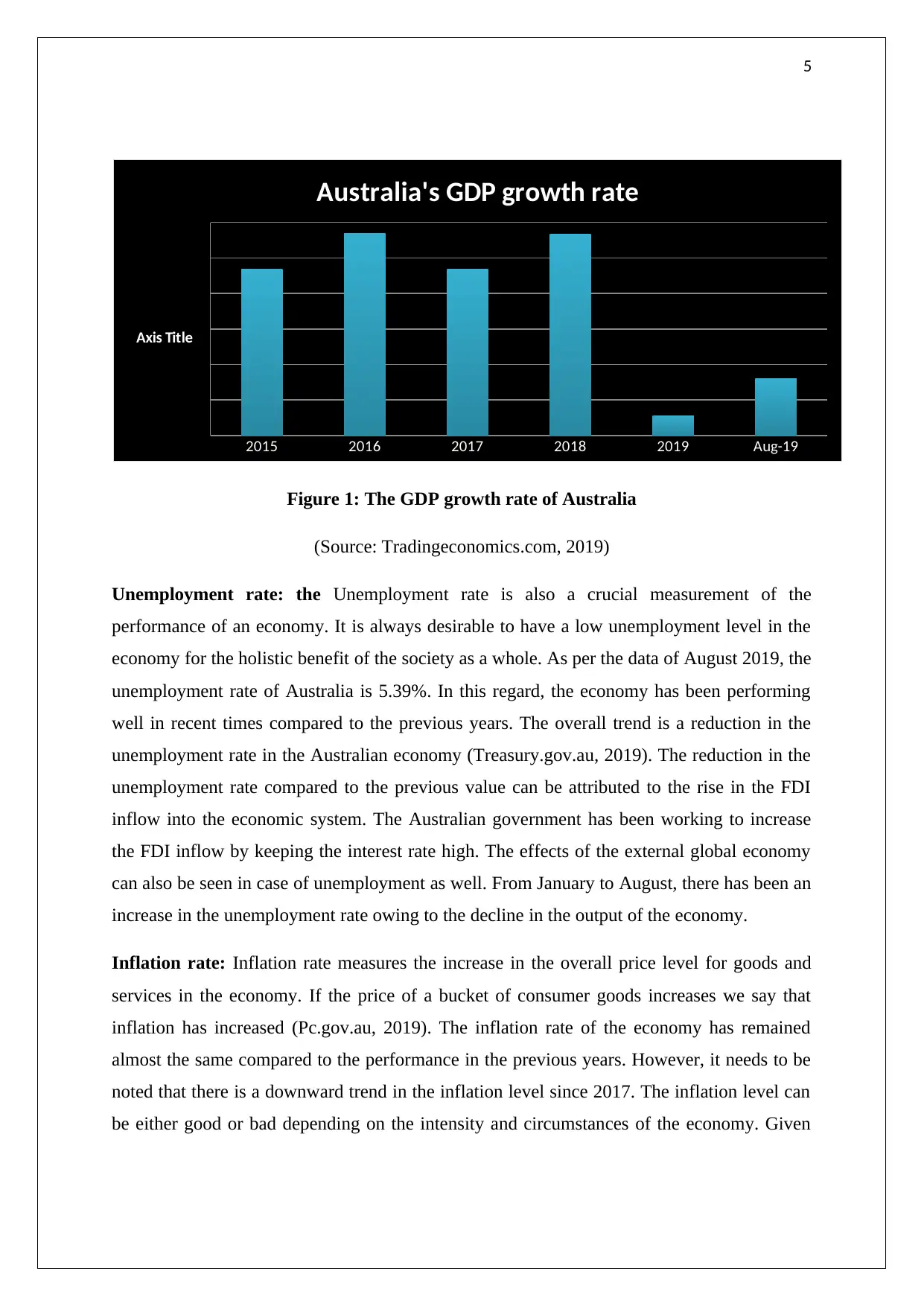
5
Figure 1: The GDP growth rate of Australia
(Source: Tradingeconomics.com, 2019)
Unemployment rate: the Unemployment rate is also a crucial measurement of the
performance of an economy. It is always desirable to have a low unemployment level in the
economy for the holistic benefit of the society as a whole. As per the data of August 2019, the
unemployment rate of Australia is 5.39%. In this regard, the economy has been performing
well in recent times compared to the previous years. The overall trend is a reduction in the
unemployment rate in the Australian economy (Treasury.gov.au, 2019). The reduction in the
unemployment rate compared to the previous value can be attributed to the rise in the FDI
inflow into the economic system. The Australian government has been working to increase
the FDI inflow by keeping the interest rate high. The effects of the external global economy
can also be seen in case of unemployment as well. From January to August, there has been an
increase in the unemployment rate owing to the decline in the output of the economy.
Inflation rate: Inflation rate measures the increase in the overall price level for goods and
services in the economy. If the price of a bucket of consumer goods increases we say that
inflation has increased (Pc.gov.au, 2019). The inflation rate of the economy has remained
almost the same compared to the performance in the previous years. However, it needs to be
noted that there is a downward trend in the inflation level since 2017. The inflation level can
be either good or bad depending on the intensity and circumstances of the economy. Given
2015 2016 2017 2018 2019 Aug-19
Australia's GDP growth rate
Axis Title
Figure 1: The GDP growth rate of Australia
(Source: Tradingeconomics.com, 2019)
Unemployment rate: the Unemployment rate is also a crucial measurement of the
performance of an economy. It is always desirable to have a low unemployment level in the
economy for the holistic benefit of the society as a whole. As per the data of August 2019, the
unemployment rate of Australia is 5.39%. In this regard, the economy has been performing
well in recent times compared to the previous years. The overall trend is a reduction in the
unemployment rate in the Australian economy (Treasury.gov.au, 2019). The reduction in the
unemployment rate compared to the previous value can be attributed to the rise in the FDI
inflow into the economic system. The Australian government has been working to increase
the FDI inflow by keeping the interest rate high. The effects of the external global economy
can also be seen in case of unemployment as well. From January to August, there has been an
increase in the unemployment rate owing to the decline in the output of the economy.
Inflation rate: Inflation rate measures the increase in the overall price level for goods and
services in the economy. If the price of a bucket of consumer goods increases we say that
inflation has increased (Pc.gov.au, 2019). The inflation rate of the economy has remained
almost the same compared to the performance in the previous years. However, it needs to be
noted that there is a downward trend in the inflation level since 2017. The inflation level can
be either good or bad depending on the intensity and circumstances of the economy. Given
2015 2016 2017 2018 2019 Aug-19
Australia's GDP growth rate
Axis Title
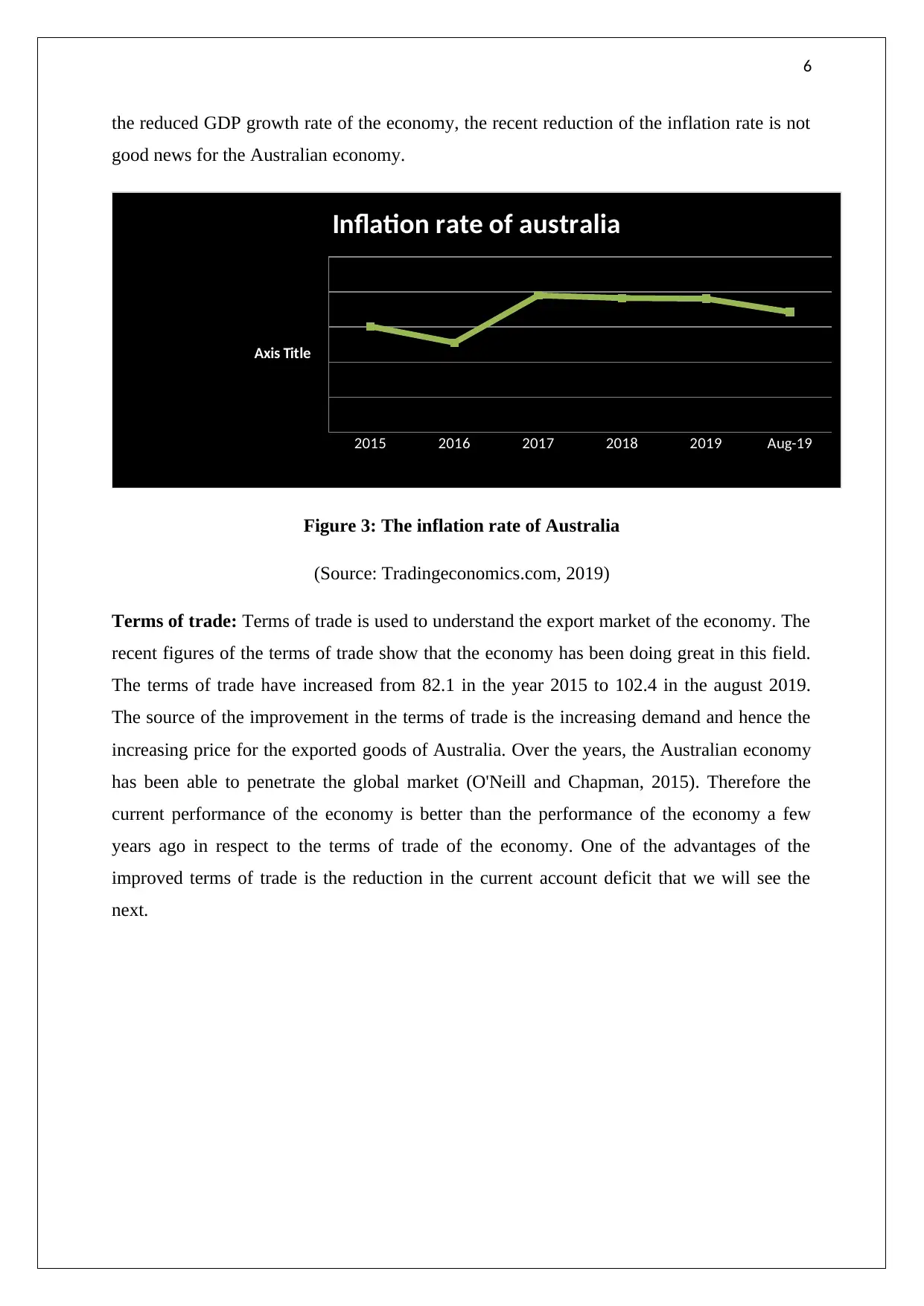
6
the reduced GDP growth rate of the economy, the recent reduction of the inflation rate is not
good news for the Australian economy.
2015 2016 2017 2018 2019 Aug-19
Inflation rate of australia
Axis Title
Figure 3: The inflation rate of Australia
(Source: Tradingeconomics.com, 2019)
Terms of trade: Terms of trade is used to understand the export market of the economy. The
recent figures of the terms of trade show that the economy has been doing great in this field.
The terms of trade have increased from 82.1 in the year 2015 to 102.4 in the august 2019.
The source of the improvement in the terms of trade is the increasing demand and hence the
increasing price for the exported goods of Australia. Over the years, the Australian economy
has been able to penetrate the global market (O'Neill and Chapman, 2015). Therefore the
current performance of the economy is better than the performance of the economy a few
years ago in respect to the terms of trade of the economy. One of the advantages of the
improved terms of trade is the reduction in the current account deficit that we will see the
next.
the reduced GDP growth rate of the economy, the recent reduction of the inflation rate is not
good news for the Australian economy.
2015 2016 2017 2018 2019 Aug-19
Inflation rate of australia
Axis Title
Figure 3: The inflation rate of Australia
(Source: Tradingeconomics.com, 2019)
Terms of trade: Terms of trade is used to understand the export market of the economy. The
recent figures of the terms of trade show that the economy has been doing great in this field.
The terms of trade have increased from 82.1 in the year 2015 to 102.4 in the august 2019.
The source of the improvement in the terms of trade is the increasing demand and hence the
increasing price for the exported goods of Australia. Over the years, the Australian economy
has been able to penetrate the global market (O'Neill and Chapman, 2015). Therefore the
current performance of the economy is better than the performance of the economy a few
years ago in respect to the terms of trade of the economy. One of the advantages of the
improved terms of trade is the reduction in the current account deficit that we will see the
next.
⊘ This is a preview!⊘
Do you want full access?
Subscribe today to unlock all pages.

Trusted by 1+ million students worldwide
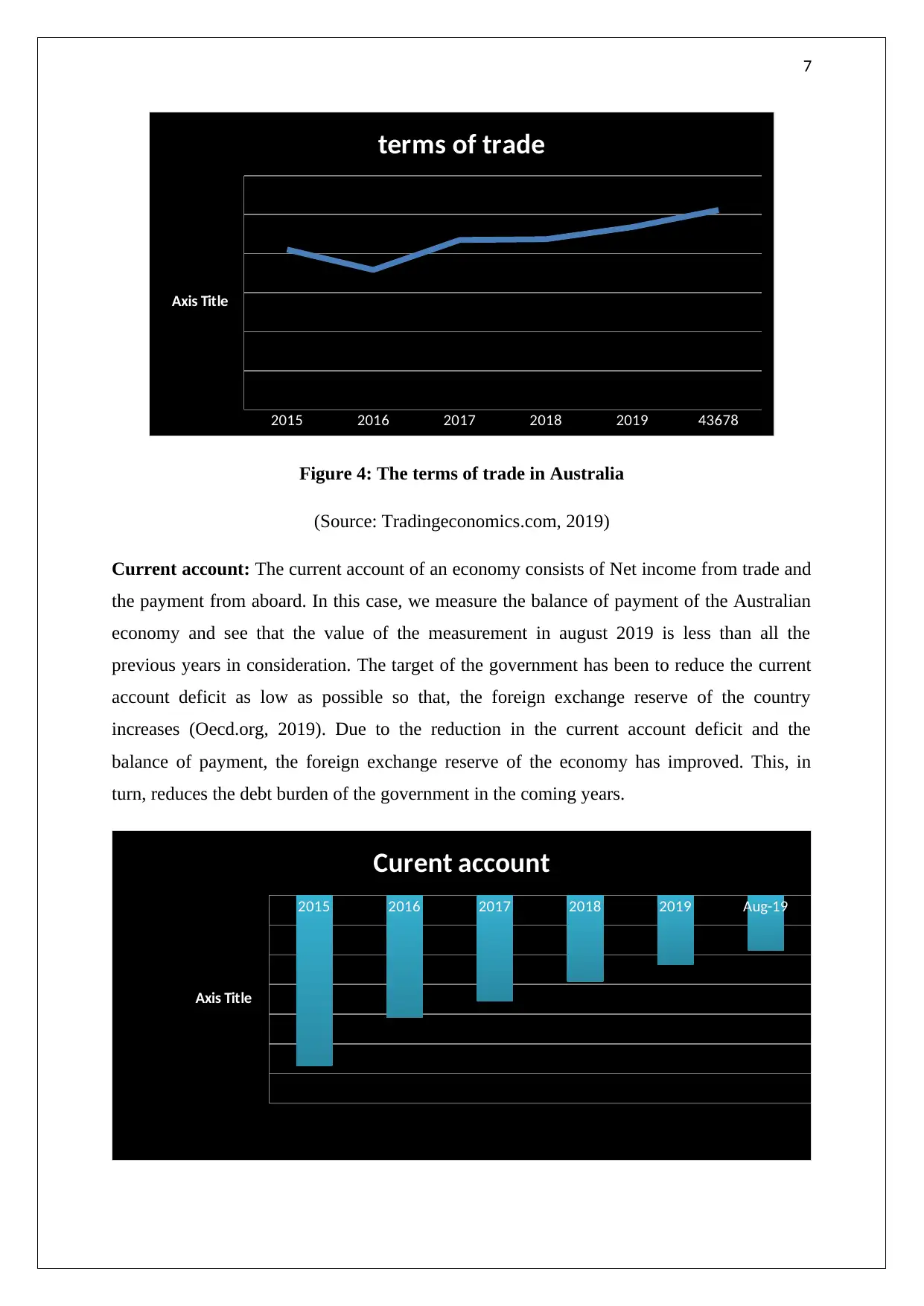
7
2015 2016 2017 2018 2019 43678
terms of trade
Axis Title
Figure 4: The terms of trade in Australia
(Source: Tradingeconomics.com, 2019)
Current account: The current account of an economy consists of Net income from trade and
the payment from aboard. In this case, we measure the balance of payment of the Australian
economy and see that the value of the measurement in august 2019 is less than all the
previous years in consideration. The target of the government has been to reduce the current
account deficit as low as possible so that, the foreign exchange reserve of the country
increases (Oecd.org, 2019). Due to the reduction in the current account deficit and the
balance of payment, the foreign exchange reserve of the economy has improved. This, in
turn, reduces the debt burden of the government in the coming years.
2015 2016 2017 2018 2019 Aug-19
Curent account
Axis Title
2015 2016 2017 2018 2019 43678
terms of trade
Axis Title
Figure 4: The terms of trade in Australia
(Source: Tradingeconomics.com, 2019)
Current account: The current account of an economy consists of Net income from trade and
the payment from aboard. In this case, we measure the balance of payment of the Australian
economy and see that the value of the measurement in august 2019 is less than all the
previous years in consideration. The target of the government has been to reduce the current
account deficit as low as possible so that, the foreign exchange reserve of the country
increases (Oecd.org, 2019). Due to the reduction in the current account deficit and the
balance of payment, the foreign exchange reserve of the economy has improved. This, in
turn, reduces the debt burden of the government in the coming years.
2015 2016 2017 2018 2019 Aug-19
Curent account
Axis Title
Paraphrase This Document
Need a fresh take? Get an instant paraphrase of this document with our AI Paraphraser
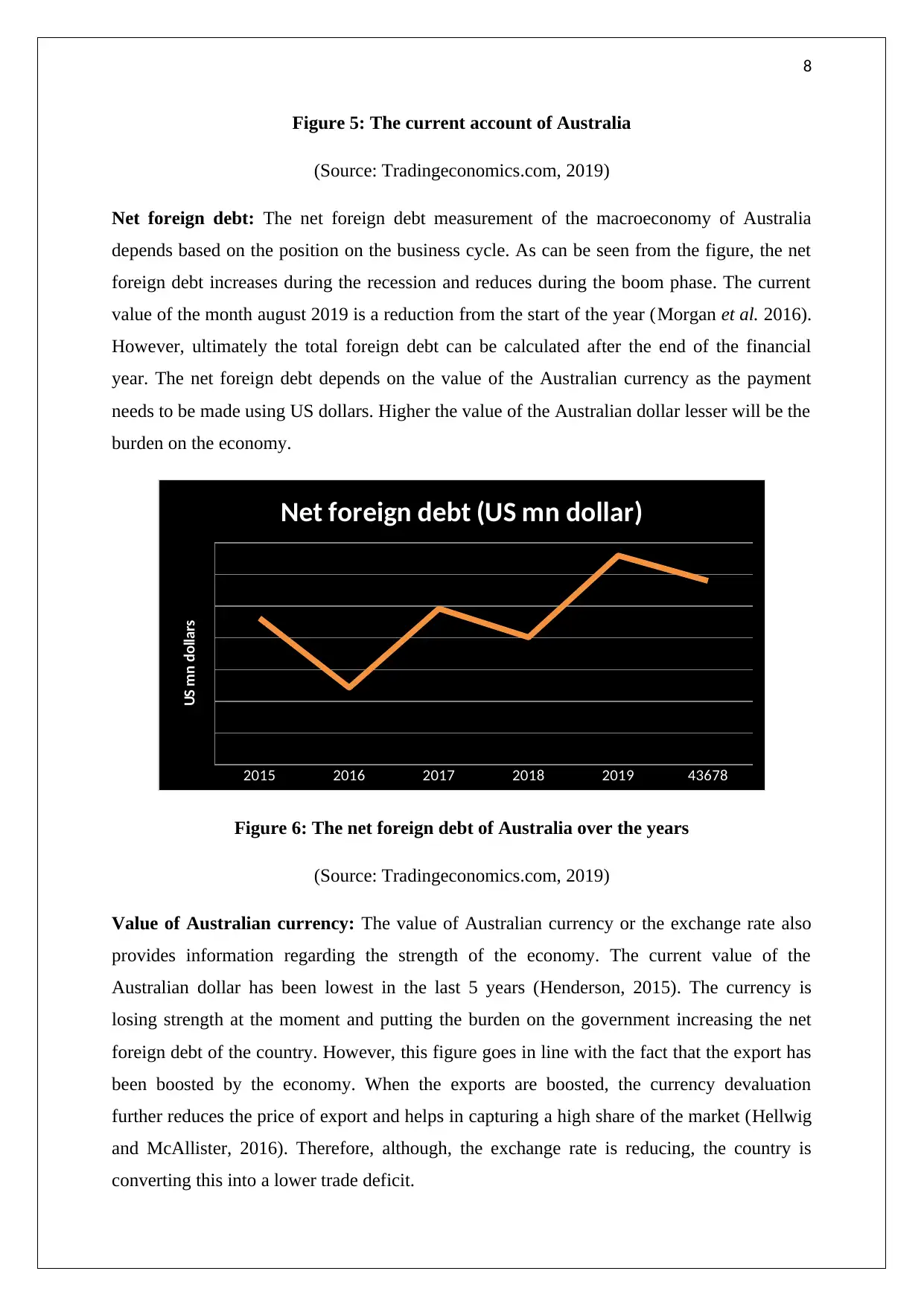
8
Figure 5: The current account of Australia
(Source: Tradingeconomics.com, 2019)
Net foreign debt: The net foreign debt measurement of the macroeconomy of Australia
depends based on the position on the business cycle. As can be seen from the figure, the net
foreign debt increases during the recession and reduces during the boom phase. The current
value of the month august 2019 is a reduction from the start of the year (Morgan et al. 2016).
However, ultimately the total foreign debt can be calculated after the end of the financial
year. The net foreign debt depends on the value of the Australian currency as the payment
needs to be made using US dollars. Higher the value of the Australian dollar lesser will be the
burden on the economy.
2015 2016 2017 2018 2019 43678
Net foreign debt (US mn dollar)
US mn dollars
Figure 6: The net foreign debt of Australia over the years
(Source: Tradingeconomics.com, 2019)
Value of Australian currency: The value of Australian currency or the exchange rate also
provides information regarding the strength of the economy. The current value of the
Australian dollar has been lowest in the last 5 years (Henderson, 2015). The currency is
losing strength at the moment and putting the burden on the government increasing the net
foreign debt of the country. However, this figure goes in line with the fact that the export has
been boosted by the economy. When the exports are boosted, the currency devaluation
further reduces the price of export and helps in capturing a high share of the market (Hellwig
and McAllister, 2016). Therefore, although, the exchange rate is reducing, the country is
converting this into a lower trade deficit.
Figure 5: The current account of Australia
(Source: Tradingeconomics.com, 2019)
Net foreign debt: The net foreign debt measurement of the macroeconomy of Australia
depends based on the position on the business cycle. As can be seen from the figure, the net
foreign debt increases during the recession and reduces during the boom phase. The current
value of the month august 2019 is a reduction from the start of the year (Morgan et al. 2016).
However, ultimately the total foreign debt can be calculated after the end of the financial
year. The net foreign debt depends on the value of the Australian currency as the payment
needs to be made using US dollars. Higher the value of the Australian dollar lesser will be the
burden on the economy.
2015 2016 2017 2018 2019 43678
Net foreign debt (US mn dollar)
US mn dollars
Figure 6: The net foreign debt of Australia over the years
(Source: Tradingeconomics.com, 2019)
Value of Australian currency: The value of Australian currency or the exchange rate also
provides information regarding the strength of the economy. The current value of the
Australian dollar has been lowest in the last 5 years (Henderson, 2015). The currency is
losing strength at the moment and putting the burden on the government increasing the net
foreign debt of the country. However, this figure goes in line with the fact that the export has
been boosted by the economy. When the exports are boosted, the currency devaluation
further reduces the price of export and helps in capturing a high share of the market (Hellwig
and McAllister, 2016). Therefore, although, the exchange rate is reducing, the country is
converting this into a lower trade deficit.
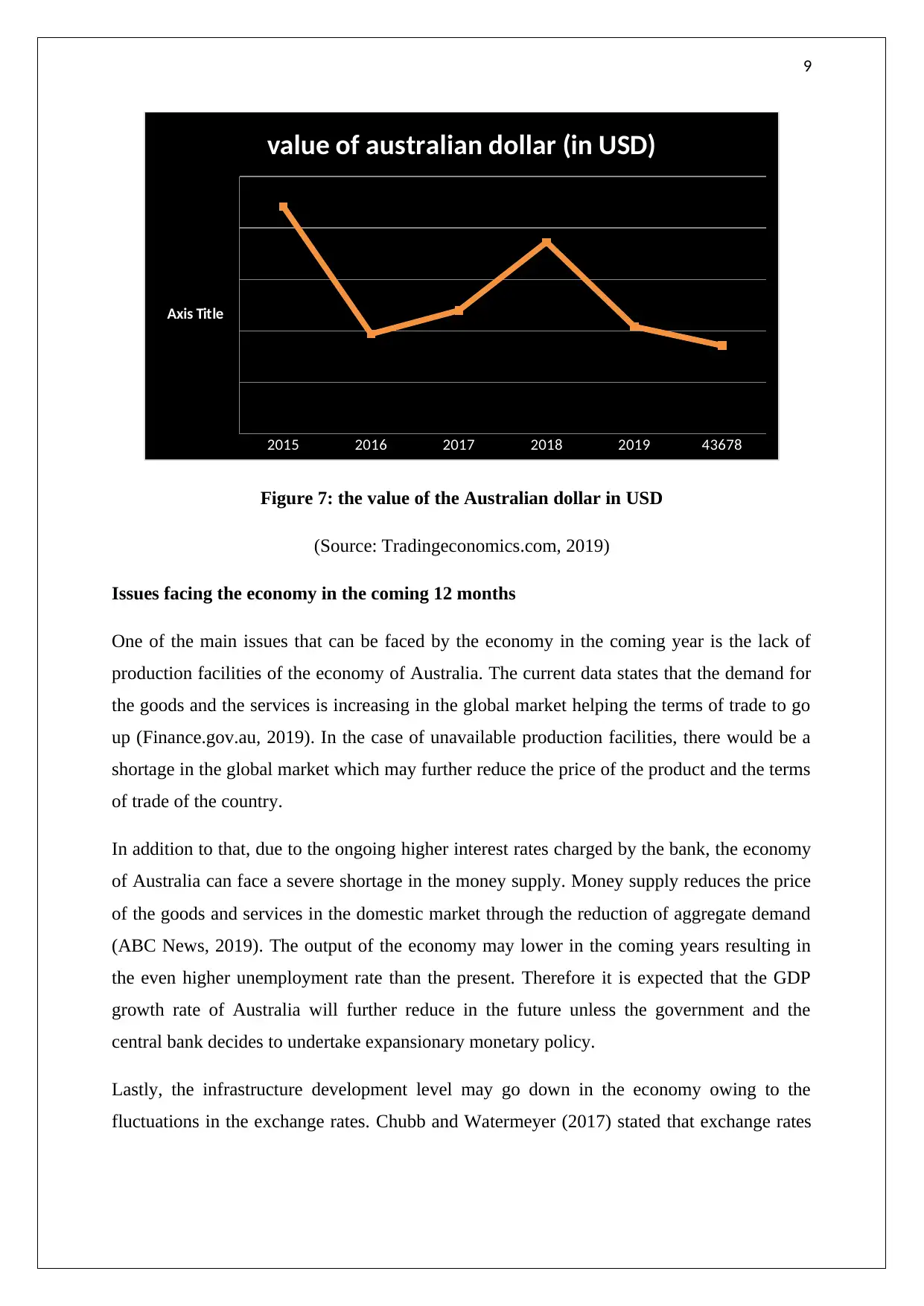
9
2015 2016 2017 2018 2019 43678
value of australian dollar (in USD)
Axis Title
Figure 7: the value of the Australian dollar in USD
(Source: Tradingeconomics.com, 2019)
Issues facing the economy in the coming 12 months
One of the main issues that can be faced by the economy in the coming year is the lack of
production facilities of the economy of Australia. The current data states that the demand for
the goods and the services is increasing in the global market helping the terms of trade to go
up (Finance.gov.au, 2019). In the case of unavailable production facilities, there would be a
shortage in the global market which may further reduce the price of the product and the terms
of trade of the country.
In addition to that, due to the ongoing higher interest rates charged by the bank, the economy
of Australia can face a severe shortage in the money supply. Money supply reduces the price
of the goods and services in the domestic market through the reduction of aggregate demand
(ABC News, 2019). The output of the economy may lower in the coming years resulting in
the even higher unemployment rate than the present. Therefore it is expected that the GDP
growth rate of Australia will further reduce in the future unless the government and the
central bank decides to undertake expansionary monetary policy.
Lastly, the infrastructure development level may go down in the economy owing to the
fluctuations in the exchange rates. Chubb and Watermeyer (2017) stated that exchange rates
2015 2016 2017 2018 2019 43678
value of australian dollar (in USD)
Axis Title
Figure 7: the value of the Australian dollar in USD
(Source: Tradingeconomics.com, 2019)
Issues facing the economy in the coming 12 months
One of the main issues that can be faced by the economy in the coming year is the lack of
production facilities of the economy of Australia. The current data states that the demand for
the goods and the services is increasing in the global market helping the terms of trade to go
up (Finance.gov.au, 2019). In the case of unavailable production facilities, there would be a
shortage in the global market which may further reduce the price of the product and the terms
of trade of the country.
In addition to that, due to the ongoing higher interest rates charged by the bank, the economy
of Australia can face a severe shortage in the money supply. Money supply reduces the price
of the goods and services in the domestic market through the reduction of aggregate demand
(ABC News, 2019). The output of the economy may lower in the coming years resulting in
the even higher unemployment rate than the present. Therefore it is expected that the GDP
growth rate of Australia will further reduce in the future unless the government and the
central bank decides to undertake expansionary monetary policy.
Lastly, the infrastructure development level may go down in the economy owing to the
fluctuations in the exchange rates. Chubb and Watermeyer (2017) stated that exchange rates
⊘ This is a preview!⊘
Do you want full access?
Subscribe today to unlock all pages.

Trusted by 1+ million students worldwide
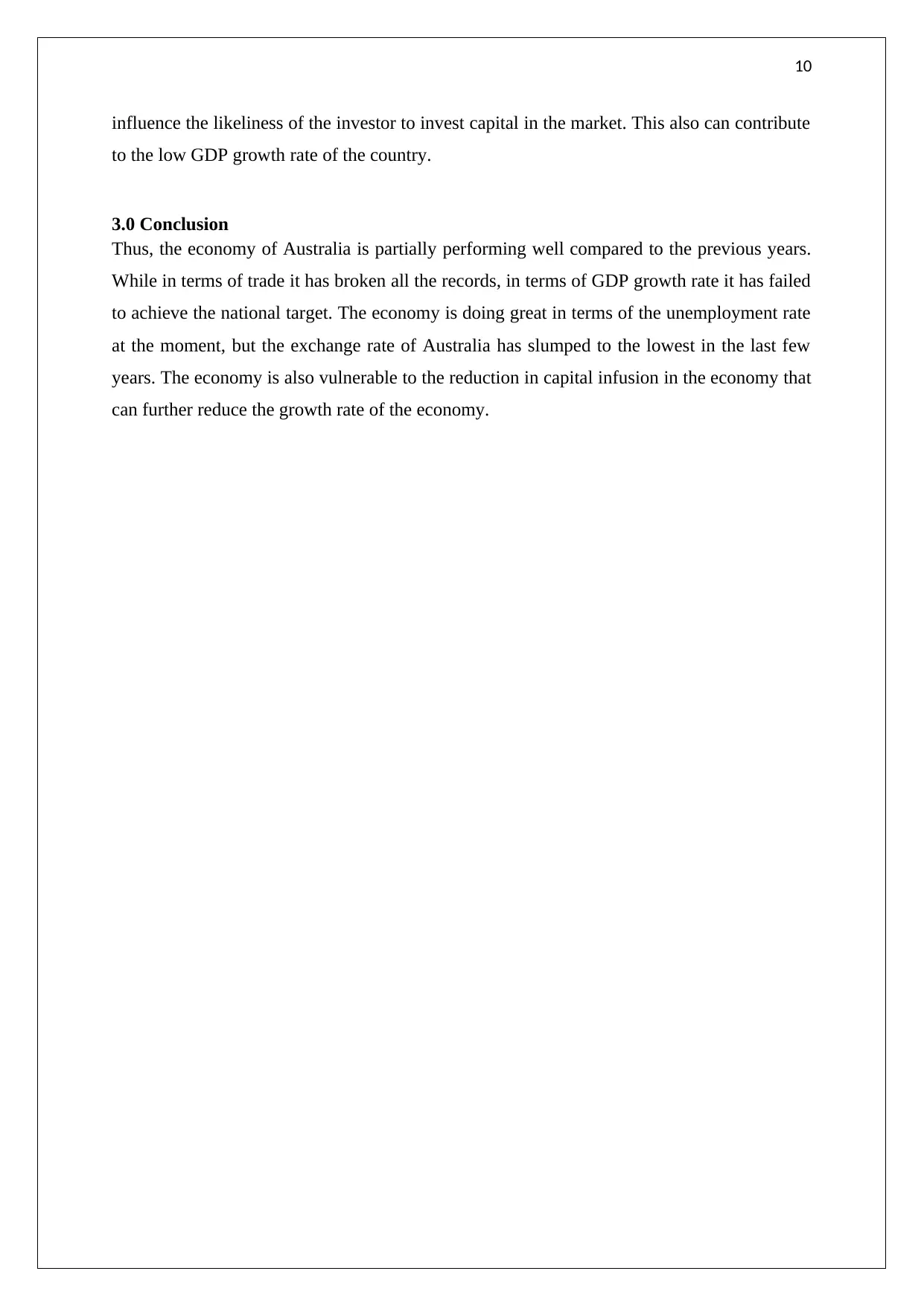
10
influence the likeliness of the investor to invest capital in the market. This also can contribute
to the low GDP growth rate of the country.
3.0 Conclusion
Thus, the economy of Australia is partially performing well compared to the previous years.
While in terms of trade it has broken all the records, in terms of GDP growth rate it has failed
to achieve the national target. The economy is doing great in terms of the unemployment rate
at the moment, but the exchange rate of Australia has slumped to the lowest in the last few
years. The economy is also vulnerable to the reduction in capital infusion in the economy that
can further reduce the growth rate of the economy.
influence the likeliness of the investor to invest capital in the market. This also can contribute
to the low GDP growth rate of the country.
3.0 Conclusion
Thus, the economy of Australia is partially performing well compared to the previous years.
While in terms of trade it has broken all the records, in terms of GDP growth rate it has failed
to achieve the national target. The economy is doing great in terms of the unemployment rate
at the moment, but the exchange rate of Australia has slumped to the lowest in the last few
years. The economy is also vulnerable to the reduction in capital infusion in the economy that
can further reduce the growth rate of the economy.
Paraphrase This Document
Need a fresh take? Get an instant paraphrase of this document with our AI Paraphraser
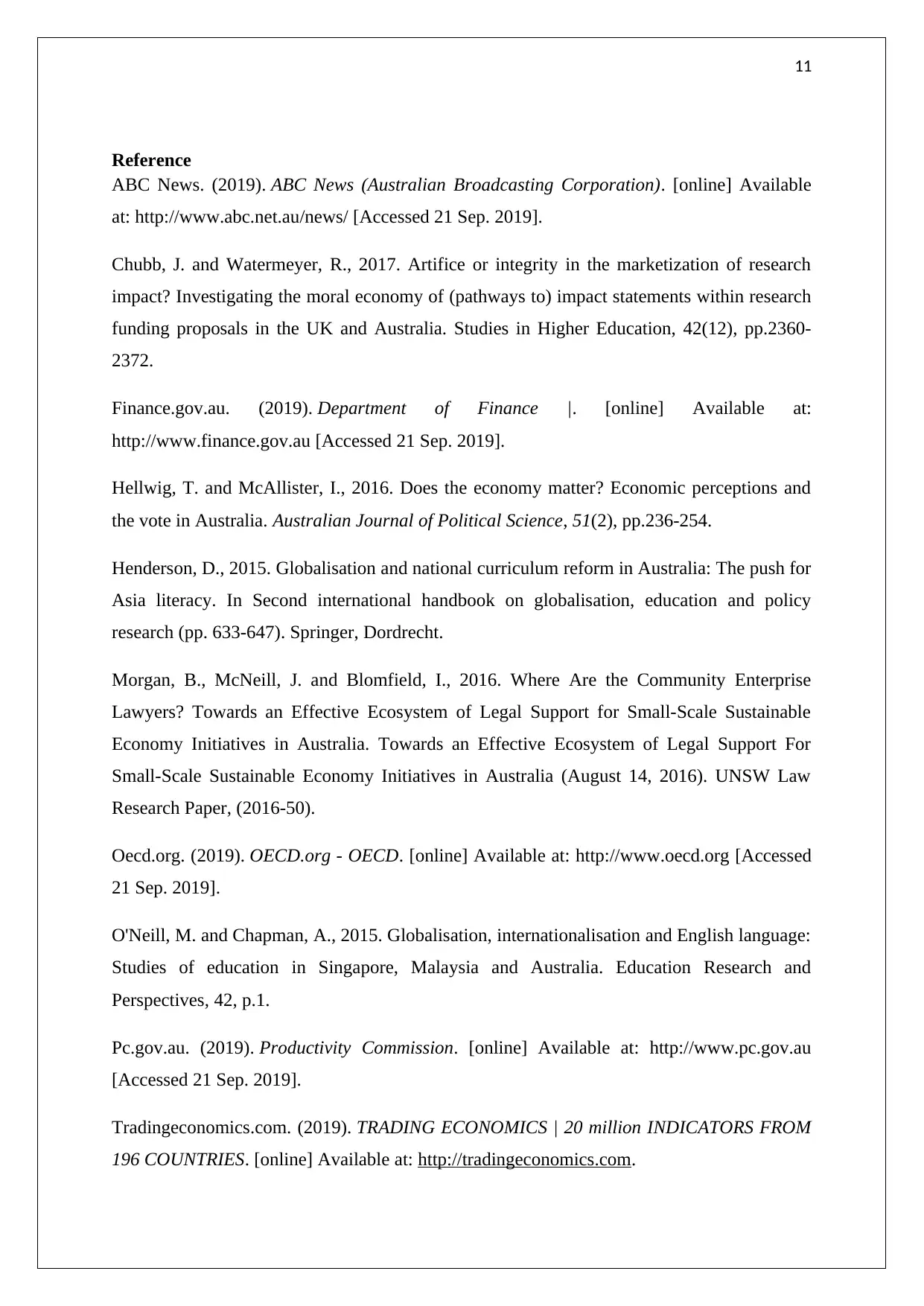
11
Reference
ABC News. (2019). ABC News (Australian Broadcasting Corporation). [online] Available
at: http://www.abc.net.au/news/ [Accessed 21 Sep. 2019].
Chubb, J. and Watermeyer, R., 2017. Artifice or integrity in the marketization of research
impact? Investigating the moral economy of (pathways to) impact statements within research
funding proposals in the UK and Australia. Studies in Higher Education, 42(12), pp.2360-
2372.
Finance.gov.au. (2019). Department of Finance |. [online] Available at:
http://www.finance.gov.au [Accessed 21 Sep. 2019].
Hellwig, T. and McAllister, I., 2016. Does the economy matter? Economic perceptions and
the vote in Australia. Australian Journal of Political Science, 51(2), pp.236-254.
Henderson, D., 2015. Globalisation and national curriculum reform in Australia: The push for
Asia literacy. In Second international handbook on globalisation, education and policy
research (pp. 633-647). Springer, Dordrecht.
Morgan, B., McNeill, J. and Blomfield, I., 2016. Where Are the Community Enterprise
Lawyers? Towards an Effective Ecosystem of Legal Support for Small-Scale Sustainable
Economy Initiatives in Australia. Towards an Effective Ecosystem of Legal Support For
Small-Scale Sustainable Economy Initiatives in Australia (August 14, 2016). UNSW Law
Research Paper, (2016-50).
Oecd.org. (2019). OECD.org - OECD. [online] Available at: http://www.oecd.org [Accessed
21 Sep. 2019].
O'Neill, M. and Chapman, A., 2015. Globalisation, internationalisation and English language:
Studies of education in Singapore, Malaysia and Australia. Education Research and
Perspectives, 42, p.1.
Pc.gov.au. (2019). Productivity Commission. [online] Available at: http://www.pc.gov.au
[Accessed 21 Sep. 2019].
Tradingeconomics.com. (2019). TRADING ECONOMICS | 20 million INDICATORS FROM
196 COUNTRIES. [online] Available at: http://tradingeconomics.com.
Reference
ABC News. (2019). ABC News (Australian Broadcasting Corporation). [online] Available
at: http://www.abc.net.au/news/ [Accessed 21 Sep. 2019].
Chubb, J. and Watermeyer, R., 2017. Artifice or integrity in the marketization of research
impact? Investigating the moral economy of (pathways to) impact statements within research
funding proposals in the UK and Australia. Studies in Higher Education, 42(12), pp.2360-
2372.
Finance.gov.au. (2019). Department of Finance |. [online] Available at:
http://www.finance.gov.au [Accessed 21 Sep. 2019].
Hellwig, T. and McAllister, I., 2016. Does the economy matter? Economic perceptions and
the vote in Australia. Australian Journal of Political Science, 51(2), pp.236-254.
Henderson, D., 2015. Globalisation and national curriculum reform in Australia: The push for
Asia literacy. In Second international handbook on globalisation, education and policy
research (pp. 633-647). Springer, Dordrecht.
Morgan, B., McNeill, J. and Blomfield, I., 2016. Where Are the Community Enterprise
Lawyers? Towards an Effective Ecosystem of Legal Support for Small-Scale Sustainable
Economy Initiatives in Australia. Towards an Effective Ecosystem of Legal Support For
Small-Scale Sustainable Economy Initiatives in Australia (August 14, 2016). UNSW Law
Research Paper, (2016-50).
Oecd.org. (2019). OECD.org - OECD. [online] Available at: http://www.oecd.org [Accessed
21 Sep. 2019].
O'Neill, M. and Chapman, A., 2015. Globalisation, internationalisation and English language:
Studies of education in Singapore, Malaysia and Australia. Education Research and
Perspectives, 42, p.1.
Pc.gov.au. (2019). Productivity Commission. [online] Available at: http://www.pc.gov.au
[Accessed 21 Sep. 2019].
Tradingeconomics.com. (2019). TRADING ECONOMICS | 20 million INDICATORS FROM
196 COUNTRIES. [online] Available at: http://tradingeconomics.com.
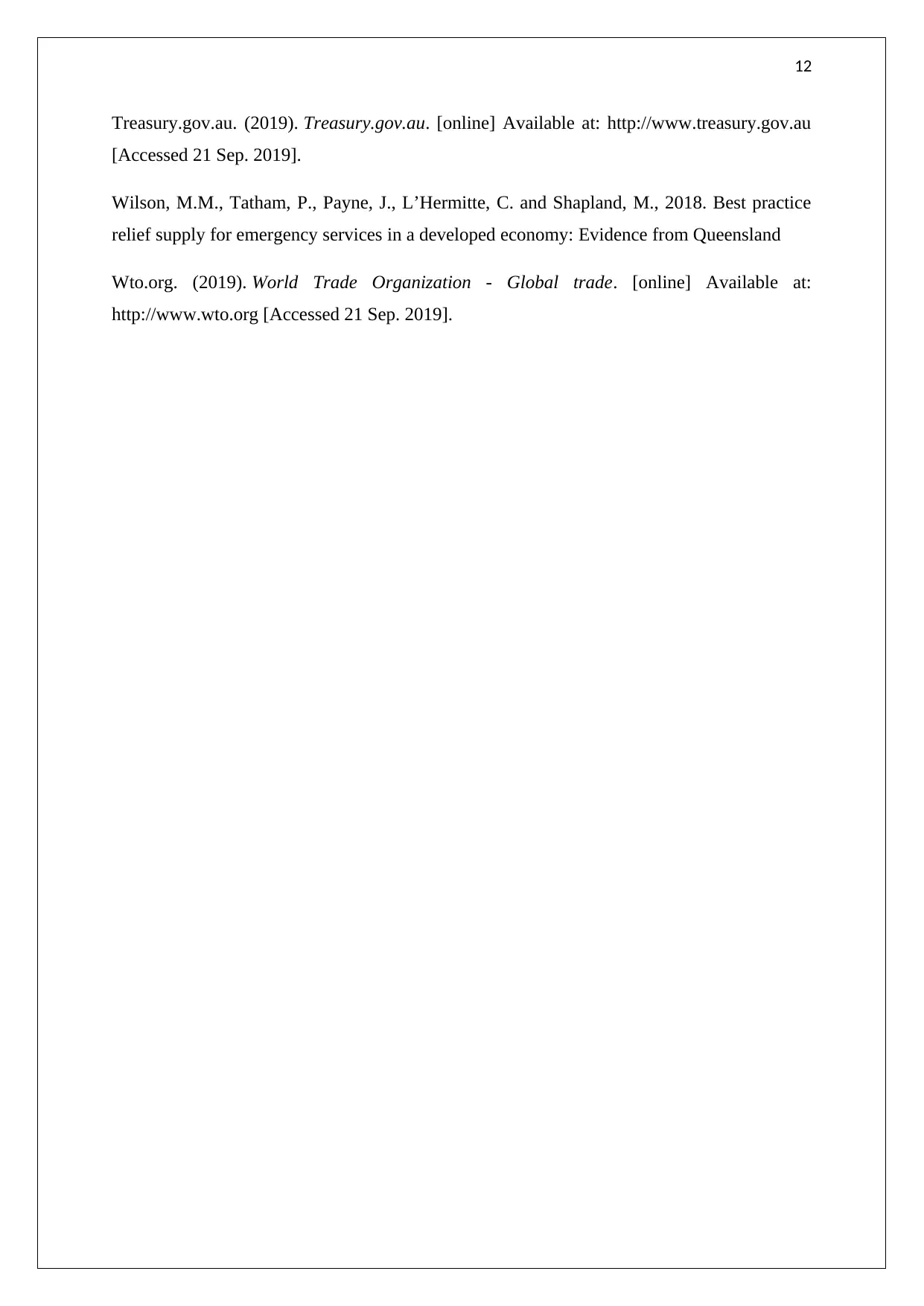
12
Treasury.gov.au. (2019). Treasury.gov.au. [online] Available at: http://www.treasury.gov.au
[Accessed 21 Sep. 2019].
Wilson, M.M., Tatham, P., Payne, J., L’Hermitte, C. and Shapland, M., 2018. Best practice
relief supply for emergency services in a developed economy: Evidence from Queensland
Wto.org. (2019). World Trade Organization - Global trade. [online] Available at:
http://www.wto.org [Accessed 21 Sep. 2019].
Treasury.gov.au. (2019). Treasury.gov.au. [online] Available at: http://www.treasury.gov.au
[Accessed 21 Sep. 2019].
Wilson, M.M., Tatham, P., Payne, J., L’Hermitte, C. and Shapland, M., 2018. Best practice
relief supply for emergency services in a developed economy: Evidence from Queensland
Wto.org. (2019). World Trade Organization - Global trade. [online] Available at:
http://www.wto.org [Accessed 21 Sep. 2019].
⊘ This is a preview!⊘
Do you want full access?
Subscribe today to unlock all pages.

Trusted by 1+ million students worldwide
1 out of 12
Related Documents
Your All-in-One AI-Powered Toolkit for Academic Success.
+13062052269
info@desklib.com
Available 24*7 on WhatsApp / Email
![[object Object]](/_next/static/media/star-bottom.7253800d.svg)
Unlock your academic potential
Copyright © 2020–2025 A2Z Services. All Rights Reserved. Developed and managed by ZUCOL.





